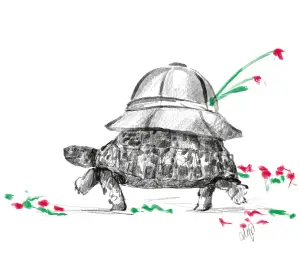A brief explanation about the migratory restlessness of the fantastic...
ViewA few ground rules
To ensure a safe and enjoyable vacation.
- Rule # 1: In Namibia you don't drive or go anywhere without a jacket, hat and enough water!
- We have meticulously organized practical logistics for your convenience. However, it is advisable to thoroughly prepare for the driving distances and route ahead.
- Kindly ensure punctuality as the routes in Namibia can be extensive. Anticipate an average speed of 60 km/h for your journey and plan accordingly.
- For your safety, refrain from picking up hitchhikers under any circumstances!
- Please be mindful of the prevalent theft crime in Namibia. Avoid leaving valuables in your vehicle, consistently lock the car, and refrain from enticing situations. Exercise vigilance and caution, especially in encounters with street children; it is advisable not to offer them anything under any circumstances.
- Exercise caution if waved off the road and solicited for help. If uncertain or uneasy, prioritize your safety and continue driving.
- Kindly refuel whenever possible. Ensure that the tires maintain a pressure of at least 2 bar, verify the correct oil level, and securely close the oil check cap. If the red warning lights illuminate on gravel roads, it is advisable to inspect the v-belts.
- Always carry an ample supply of water and provisions. Pre-order lunch packs from accommodations the night before departure. Remember, water is essential for life, so ensure you have enough for yourself and, if possible, consider fellow travelers who may not have made similar preparations.
Changing car tyres
When changing tires, exercise caution and focus by following these steps:
- Engage the handbrake.
- Keep the car in a straight position.
- Place stones in front and behind the intact tires.
- Ensure a stable position of the jack.
- Slightly loosen tire nuts before lifting the vehicle.
- Unload or remove the spare tire before lifting the car.
- Ensure all individuals are out of the car, with no one underneath, before lifting.
- Lift the car until the tire is suspended, swiftly unscrew the nuts, and replace with the spare tire.
- Tighten nuts in a crosswise pattern.
- Lower the jack and tighten wheel nuts thoroughly once again.
- Double-check the nut tightness.
If offered assistance, be vigilant about the contents of your vehicle.
Note: You have two spare tires; promptly repair any damaged tire. Verify that your insurance covers accidents abroad.
For emergency assistance, contact EMED Rescue 24 at 081 924 or +264 61 411600.
Notes from the Embassy:
A concerning number of vacationers experience serious accidents on Namibia’s roads, often resulting in fatalities. These accidents typically involve rollovers due to excessive speed, rather than collisions with other vehicles. The German Embassy urgently appeals to your personal safety and that of your family, emphasizing the following advice:
Self-driving Experience:
- While self-driving with a rental car in Namibia is generally enjoyable, do not assume that the provided rental car is consistently maintained according to European standards by all rental companies.
Vehicle Inspection:
- Prioritize safety by thoroughly checking the brakes and tire condition for reliability. If feasible, carry two spare wheels due to frequent punctures on gravel roads.
Driving Practices:
- Due to the unfamiliar left-hand traffic (to some countries) and road conditions, adopt a defensive and moderate driving approach. Always wear your seat belt.
Speed Limits:
- Exercise caution with speed, as sudden crosswinds can make 120 km/h on asphalt roads too fast. On gravel roads, speeds exceeding 90 km/h are already risky. Control your car effectively at 80 km/h, with a recommended speed of 60 – 70 km/h.
Country Roads Caution:
- The roads in Namibia may create a false sense of security due to low traffic, but be wary of dangerous overtaking maneuvers in blind curves or before hills obstructing your view.
Animal Hazards:
- Expect animals (game, cattle, or goats) crossing the road, particularly during twilight and night hours. Collisions with large animals are comparable to those with middle-class cars and often result in serious or fatal accidents.
Gravel Road Challenges:
- Maintain a speed below 80 km/h on gravel roads to avoid skidding, especially on straight roads. Avoid changing lanes over gravel accumulations, and refrain from overtaking if the dust plume obscures your view of oncoming traffic.
Adverse Weather Conditions:
- During the rainy season, be cautious of flooded roads, driving slowly through flooded sections to prevent fatal rollovers.
Skidding and Rollover Prevention:
- If skidding, avoid over-correcting the steering and full braking. Steer in the direction of centrifugal force, avoiding obstacles. On gravel roads, especially on curves and downhill slopes, exercise extreme caution to prevent skidding and rollovers.
Emergency Preparedness:
- Be cautious with 4×4 vehicles, particularly those with roof loads. Do not solely rely on your mobile phone, as cellular reception is limited outside populated areas.
A self-drive tour in Namibia can be a pleasurable experience when approached with appropriate care and attention to safety. Have a wonderful and safe stay!
This could also interest you:
Wearing the correct hat on a safari in Namibia
The text humorously reflects on the psychology of hats, suggesting...
ViewEmotional Men and a Botanical Miracle
Friedrich Welwitsch, Thomas Baines, and David Livingstone: The Discovery of...
View



